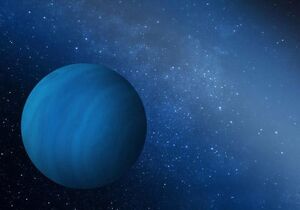
A rogue planet is a free floating planet. It does not orbit a star. Even so, it can be within an artificial Habitable Zone.
Characteristics[]
More details are available here.
Rogue planet are of two origins. Some of them have been ejected from their host stars by gravitational perturbations. Others can be created from small clouds of gas and dust, similar to a star formation. If the planets are still warm, they are Hot planets. However, without a source of fusion, temperature will decrease dramatically. It is also possible that matter accretion was very slow, so that the planet had enough time to cool, never being heated enough.
Rogue planets might have all types of mass. Some of them (those detected so far) are Jupiter-size. There are for sure also smaller ones, with Earth-like dimensions and even far smaller. There are certainly also rogue asteroids, ejected from a nearby star or creating from a very small cloud of gas and dust.
If a rogue planet was created inside a star system, it should contain less volatiles. Let's hypothesize that our sun, Sol, gets too close to another star and all planets escape into space. They will freeze to nearly absolute zero, but a well-experienced astronomer will still be able to find their origin. Mercury will have only very small amounts of water and volatiles, while Earth will have many with valleys on its surface. The absence of water on Venus will be a clue that this planet was exposed to a solar wind. The lack of methane on Jovian moons will prove that they experienced temperatures where this gas would evaporate. Even Pluto, since it has no hydrogen or helium molecules on its surface, proves that it once was exposed to temperatures where these gases would sublimate and escape thanks to their low mass.
Planets created in the interstellar environment should be more different. As the temperature gets close to absolute zero, all elements are frozen on their surface. Yes, in case of gas giants, their internal temperature should still keep an atmosphere (but not forever), but for a rocky planet, a year's exposure to interstellar cold will cause everything be frozen. So travelers will find resources like frozen hydrogen or helium on these bodies. In case of asteroids, since there was not enough force to compact the primordial gas and dust, they should have a very diffuse structure, very easy to break apart.
Rogue planets might have moons.
How to terraform[]
To terraform such a planet, first of all, you need a source of light and heat. An artificial sun, for example. One idea is to place satellites on orbit that will produce energy by hydrogen fusion. Greenhouse gasses would also be needed to reduce the heat output. The main advantage is that, despite the huge costs, a rogue planet will not be depending on anything: a hosting star, nearby gravity influences, or governments from other planets. Settlers will be completely on their own.
One other possibility is that rogue planets could be heated by tidal forces. If a large moon, or second planet is close enough then vast amounts of internal heat could be generated (much like the case of Io) and then a dense atmosphere could trap much of this heat and prevent it from all radiating away into space.
If a terraformed rogue planet exists at 1 light year from Earth, it will be impossible to see with naked eye or with an average telescope in the visible light spectrum. It would, however, be easily detectable in infrared.